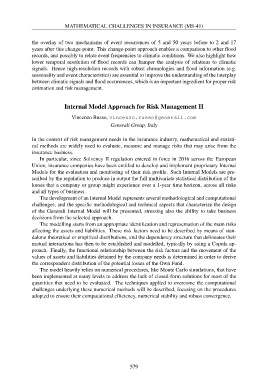Page 581 - 8th European Congress of Mathematics ∙ 20-26 June 2021 ∙ Portorož, Slovenia ∙ Book of Abstracts
P. 581
MATHEMATICAL CHALLENGES IN INSURANCE (MS-41)
the overlay of two mechanisms of event recurrences of 5 and 50 years before to 2 and 17
years after this change-point. This change-point approach enables a comparison to other flood
records, and possibly to relate event frequencies to climatic conditions. We also highlight how
lower temporal resolution of flood records can hamper the analysis of relations to climatic
signals. Hence high-resolution records with robust chronologies and flood information (e.g.
seasonality and event characteristics) are essential to improve the understanding of the interplay
between climatic signals and flood occurrences, which is an important ingredient for proper risk
estimation and risk management.
Internal Model Approach for Risk Management II
Vincenzo Russo, vincenzo.russo@generali.com
Generali Group, Italy
In the context of risk management needs in the insurance industry, mathematical and statisti-
cal methods are widely used to evaluate, measure and manage risks that may arise from the
insurance business.
In particular, since Solvency II regulation entered in force in 2016 across the European
Union, insurance companies have been entitled to develop and implement proprietary Internal
Models for the evaluation and monitoring of their risk profile. Such Internal Models are pre-
scribed by the regulation to produce in output the full multivariate statistical distribution of the
losses that a company or group might experience over a 1-year time horizon, across all risks
and all types of business.
The development of an Internal Model represents several methodological and computational
challenges, and the specific methodological and technical aspects that characterize the design
of the Generali Internal Model will be presented, stressing also the ability to take business
decisions from the selected approach.
The modelling starts from an appropriate identification and representation of the main risks
affecting the assets and liabilities. These risk factors need to be described by means of stan-
dalone theoretical or empirical distributions, and the dependency structure that delineates their
mutual interactions has then to be established and modelled, typically by using a Copula ap-
proach. Finally, the functional relationship between the risk factors and the movement of the
values of assets and liabilities detained by the company needs is determined in order to derive
the correspondent distribution of the potential losses of the Own Fund.
The model heavily relies on numerical procedures, like Monte Carlo simulations, that have
been implemented at many levels to address the lack of closed-form solutions for most of the
quantities that need to be evaluated. The techniques applied to overcome the computational
challenges underlying these numerical methods will be described, focusing on the procedures
adopted to ensure their computational efficiency, numerical stability and robust convergence.
579
the overlay of two mechanisms of event recurrences of 5 and 50 years before to 2 and 17
years after this change-point. This change-point approach enables a comparison to other flood
records, and possibly to relate event frequencies to climatic conditions. We also highlight how
lower temporal resolution of flood records can hamper the analysis of relations to climatic
signals. Hence high-resolution records with robust chronologies and flood information (e.g.
seasonality and event characteristics) are essential to improve the understanding of the interplay
between climatic signals and flood occurrences, which is an important ingredient for proper risk
estimation and risk management.
Internal Model Approach for Risk Management II
Vincenzo Russo, vincenzo.russo@generali.com
Generali Group, Italy
In the context of risk management needs in the insurance industry, mathematical and statisti-
cal methods are widely used to evaluate, measure and manage risks that may arise from the
insurance business.
In particular, since Solvency II regulation entered in force in 2016 across the European
Union, insurance companies have been entitled to develop and implement proprietary Internal
Models for the evaluation and monitoring of their risk profile. Such Internal Models are pre-
scribed by the regulation to produce in output the full multivariate statistical distribution of the
losses that a company or group might experience over a 1-year time horizon, across all risks
and all types of business.
The development of an Internal Model represents several methodological and computational
challenges, and the specific methodological and technical aspects that characterize the design
of the Generali Internal Model will be presented, stressing also the ability to take business
decisions from the selected approach.
The modelling starts from an appropriate identification and representation of the main risks
affecting the assets and liabilities. These risk factors need to be described by means of stan-
dalone theoretical or empirical distributions, and the dependency structure that delineates their
mutual interactions has then to be established and modelled, typically by using a Copula ap-
proach. Finally, the functional relationship between the risk factors and the movement of the
values of assets and liabilities detained by the company needs is determined in order to derive
the correspondent distribution of the potential losses of the Own Fund.
The model heavily relies on numerical procedures, like Monte Carlo simulations, that have
been implemented at many levels to address the lack of closed-form solutions for most of the
quantities that need to be evaluated. The techniques applied to overcome the computational
challenges underlying these numerical methods will be described, focusing on the procedures
adopted to ensure their computational efficiency, numerical stability and robust convergence.
579


